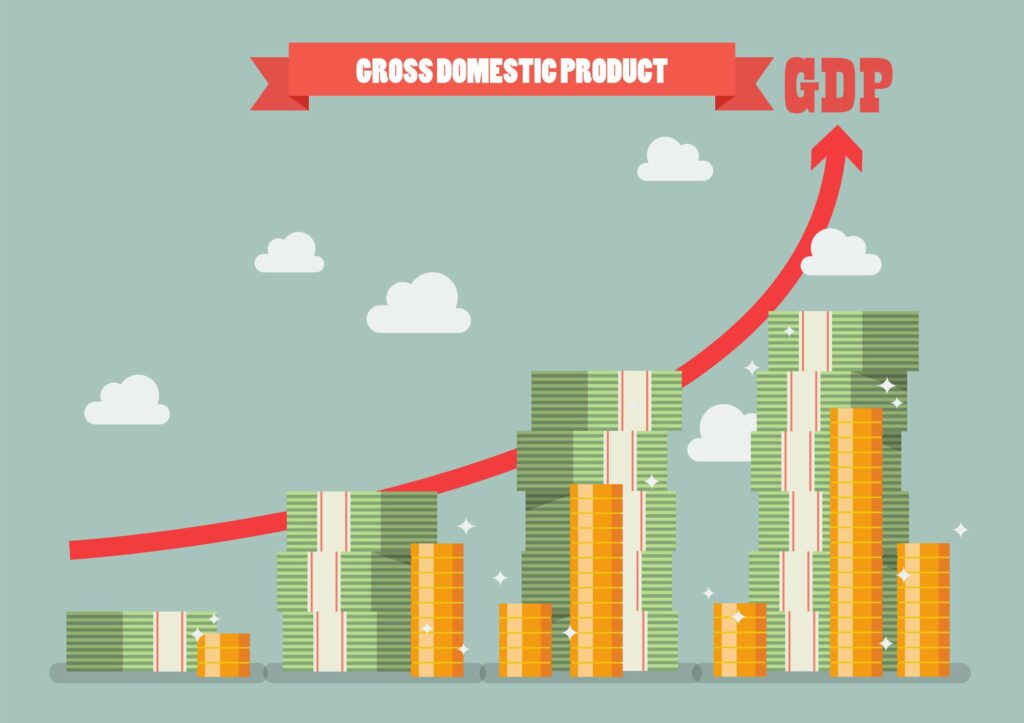Gross Domestic Product (GDP) growth is a fundamental indicator of a nation’s economic health. GDP represents the total monetary value of all goods and services produced within a country’s borders over a specified period, typically annually or quarterly. The growth of GDP signifies an increase in economic activity and is often seen as a marker of prosperity. Understanding GDP growth requires a look at its basic calculation and the components that drive it.

Calculation of GDP
The basic formula for calculating GDP is:
GDP = Consumption (C) + Investment (I) + Government Spending (G) + Net Exports (NX)
Each of these components plays a vital role in the overall GDP:
Consumption includes all private expenditures on goods and services. It is typically the largest component and reflects household spending.
Investment covers business investments in equipment and structures, residential construction, and changes in business inventories. Investment is crucial for future economic growth as it increases productive capacity.
Government Spending comprises expenditures on goods and services by government agencies. This includes defense, education, public safety, and infrastructure projects.
Net Exports is calculated as the difference between a country’s exports and imports. Positive net exports indicate a trade surplus, while negative net exports indicate a trade deficit.
ALSO READ THIS : The Bright Future Awaits: 10 Dream Jobs in 2024!
Historical Context and Types of GDP
Historically, GDP growth has been a key measure of economic progress and stability. Economists and policymakers use GDP growth rates to assess the economic performance of a country over time and to compare it with other nations. High GDP growth rates often correlate with low unemployment and higher living standards, while low or negative growth can indicate economic distress.
It is important to distinguish between nominal and real GDP. Nominal GDP measures the value of all finished goods and services produced within a country’s borders at current prices, without adjusting for inflation. In contrast, real GDP adjusts for inflation, providing a more accurate reflection of an economy’s size and how it is growing over time. Evaluating GDP growth through the lens of real GDP is crucial, as it accounts for the changes in the price level and offers a clearer picture of economic progress.
In conclusion, understanding GDP growth involves recognizing its components, the historical context of its use, and the distinction between nominal and real GDP. This comprehensive view allows for a better assessment of economic health and guides effective policy-making.
Factors Influencing GDP Growth

Gross Domestic Product (GDP) growth is determined by a multitude of factors, both from the supply and demand sides of the economy. On the supply side, technological advancements play a crucial role. For instance, the advent of the internet has significantly boosted productivity across numerous sectors, from retail to manufacturing. Companies can now operate more efficiently, reducing costs and increasing output, thereby contributing to GDP growth.
Another critical supply-side factor is labor force growth. An expanding labor force means more individuals are available to produce goods and services, which directly influences economic growth. Additionally, capital investment, such as the construction of new factories or the purchase of advanced machinery, enhances production capacity and efficiency, further driving GDP growth.
On the demand side, consumer spending is a vital component. When consumers are confident and spend more, businesses see increased revenue, which can lead to expansion and further economic activity. Government policies also play a significant role, particularly fiscal policies that involve government spending and taxation. For instance, an increase in government spending on infrastructure projects can stimulate economic activity by creating jobs and increasing demand for materials and services.
International trade is another substantial factor influencing GDP growth. Exporting goods and services to foreign markets can lead to higher production levels and economic expansion. Conversely, importing essential goods can enhance the efficiency and productivity of domestic industries.
Monetary policies, particularly those involving interest rates set by central banks, are instrumental in influencing GDP growth. Lower interest rates can stimulate borrowing and investment, which in turn can spur economic activity. Conversely, higher interest rates may slow down borrowing and spending, potentially hindering growth.
Finally, global economic conditions also impact a country’s GDP growth. Economic downturns or booms in major economies can have ripple effects worldwide. For example, a recession in a major trading partner can reduce demand for exports, thereby affecting domestic production and GDP growth. Similarly, global economic stability can enhance investor confidence and promote economic expansion.
